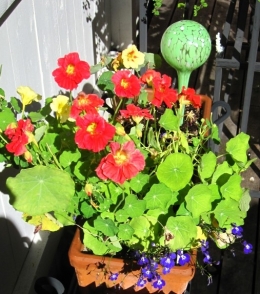May Tidings
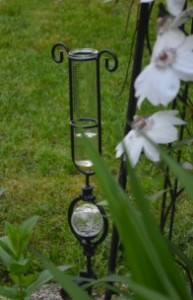
My new rain gauge near the clematis
How Dry I Am
Kate and Ryan gave me a rain gauge for my birthday. How neat. I like that it measures my rain in my yard – no more looking up our regional rainfall in the Boston Globe. I’m empowered!
Our friends, Grace and Jerry, went a step further and installed a sophisticated electronic weather monitoring system. It required them to scale heights to attach an anemometer onto their roof. I’m not there yet.
We have a winner
Also for my birthday I was gifted with a lottery ticket. It delivered me $100! I purchased with the proceeds a new white flowering dogwood (cornus florida) and heaved it into the earth close by our cherished, but aging, same variety dogwood that so beautifully graces the yard in April and May. Mild winters provide a bountiful spring bloom and there is nothing more special than that tree in our garden. Hence, adding a new generation before the old one passes.
Tick Smarts
I recently joined the Arnold Arboretum and attended a lecture there on Thursday, May 17 called “More Ticks in More Places” presented by Dr. Thomas Mather from the University of Rhode Island Tick Encounter Resource Center (tickencounter.org). Smart guy. Massachusetts and Rhode Island are the epicenter for deer tick-borne Lyme disease. It’s worth looking at his excellent website for all tick-related concerns.
Also, there’s a new tick approaching from our south called Lone Star tick – Long Island and New Jersey are already infested; it carries Rocky Mountain Spotted Fever. Fun.
As a result, I’m in the market for permethrin treated clothing and we just renewed Daphne’s “Evolution” treatment. He covered so much – dispelling myths, top ten things everyone should know, personal protection measures, safe removal, etc. Tip: after you come in from outdoor activity, throw clothes in the dryer first, then the wash. Ticks die in dry heat, but may survive washing.
A Man’s Home Is His Castle
Prepping for our golden years, we’ve begun a comprehensive house renewal program. New shingled roof, replaced worn and weathered trim boards/sills, created a portico (!) over the front door, four new windows, and new stoop and replaced cedar shingles on the back of the house. Son-in-law Ryan Flynn (yes, that Ryan Flynn) designed and crafted the portico. We’re delighted! We believe the painters will start next week. Maisy appraised our new white cedar shingles yesterday and declared: “Nice and clean!”
Midday Saturday on a beautiful May weekend. Chores. This evening we attend a performance by Coro Allegro of Rachmaninoff’s Liturgy of St. John Chrysostom at the Church of the Covenant in Back Bay.
Early Spring Dance
New England, March 2012: So odd to have late June’s cameo appearance.
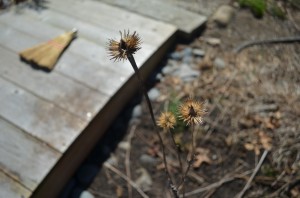
Last year's echinacea
We pensively enjoyed the abundant warmth and sunshine, while summer’s annoyances buzzed and swarmed around us, eventually driving us inside from the patio.
So many things sprang to life this week – the helleboros from Grace & Jerry, which must be thinned and would probably work better at the foot of the stone wall; our accidental hyacinth — a reliable, discarded gift from a beau to one of our teenage daughters, who are both in their 30’s now; streets bursting with magnolias already past their peak on Commonwealth Avenue, Boston; and, allergies galore.
I began clearing last year’s garden refuse and I re-installed the garden foot bridge on reset brick footings that lower the leading edge of the bridge so it’s neatly flush with the adjoining patio. This fundamental satisfaction I will enjoy forever. On walks at Humarock Beach I’m harvesting tumbled, black stones to supplement my medium hard-scape around the bridge; I will place the rounded rocks such that they become a Zen garden-like flow.
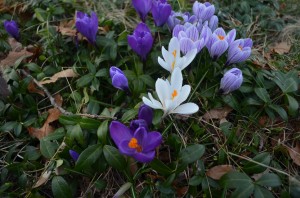
Crocus cast in myrtle
It’s too early to put out my little water feature because here in New England, in March or April, a sudden freeze can descend at any time. One doesn’t put out one’s tomatoes before Mother’s Day. My wish is for a brief cold snap to kill off the flying insects that hatched prematurely, then, a long, drawn out spring with just the right amount of rain. We can have the most spectacular Mays and Junes.
Spring is planning and planting and visioning and acting. Who knows how this season will progress? Is the sudden warmth a friendly lark or a portent of grave weather to come? Neither, both.
Garden Mind
I got the White Flower Farm Spring 2012 catalog this week. It’s a page turner as usual, with saturated floral images of garden gems in perfect flower – where the reds are redder, the greens greener and the true blues truer than life. One day, there might be a garden catalog with wilted, spent flowers going to seed. Unlikely.
My garden overwinters – stark and dreary, especially without frost or snow cover. I hope it gets cold enough to kill the bad bugs; I hope there is enough snow cover, eventually, to supplement the good stuff (my brother told me snow is the poor man’s fertilizer). But, I digress. What is really at work is stillness. No growth, just the remnants of the garden being earth bound — skeletal, essential, and creating reserves for the proper blooming time.
What I have is garden mind.
Our garden (aka, “R” Garden) sits, while last year’s beauty decomposes into next year’s growth. I see the garden’s shape from our upstairs window – the straight and curvy lines, the beds, the flow from one section to another joined by lawn, paths, steps, and bridges. I like this flow and work to refine it in my mind: firm up that edge with a low border, trim that shrub to be a better neighbor, hack that pachysandra, reset those stones, et cetera. In a process of refinement, endless tweaking shapes the garden and morphs its profile. Its essential personality, established long ago, matures incrementally, bringing charm, whimsy and nature into harmony improved by age.
Of course it’s a living thing and changes occur, apparently spontaneously, as well. Like the clumping bamboo that finally, finally decided to become the screen I imagined ten years ago. Who knew it would take this long? I suppose that’s where annuals come in. They provide the instant gratification that delights the eye and other senses. Not much mystery but adornment galore and great expectations easily met. We enjoy the splash, the visual spice, and the abundance of blooms overlaying the perennial foundation.
The garden mind dwells on ideas and suffers no toil. No: weeding, spraying, mowing, aching backs or biting no-see-ums. It sees golden possibilities; it harbors hopes and plans — flights of fancy that could occupy the whole of next season. It’s a great place to visit.
Daylilies For Sale
Marshfield is at its best in the summer. The Farmers Market runs every Friday (2-6pm). The beaches beckon. We dine al fresco. My garden flourishes and the yard becomes a leisurely extension of daily living. Other local resources make summer special, too. I recently discovered a new (to me) nearby marvel — Dick & Carolyn Houseman’s Daylilies For Sale on Union Street, Marshfield.
I know the Housemans from our bookclub. When Dick speaks, we listen. I had heard about their daylily event and Carolyn invited me to visit this year at the peak of their season. Post heat-of-the-day last Saturday, I dropped by and beheld the lilies of their fields. Wow.
no images were found
Carolyn gave me the overview: They started about 9 years ago on a partial whim, heading toward retirement.
Now both are retired and working tirelessly full time to tend the field that they started small and have grown to include over 250 daylily cultivars.Names like: Chicago Ruby, Cisty, Kindly Light, Maurice Rivero, Kwanso, Web of Intrigue, Siloam Red Ruby, Chicago Sun, Lemon Dazzler, Cedar, Monrovia Gem, Chicago (it goes on…). What’s with the preponderance of lilies named “Chicago?”
[Not a valid template]
They also have grown their mailing list to over 150 devoted followers. Loyal customers even bring plants to them – sometimes for identification, sometimes for donation. It suits them just fine and Carolyn marvels at friendly gardeners who stop by to exchange daylily tales. Gardeners are the nicest people, she says.
July is winding down. According to their schedule next weekend is the 2011 finale, until next year. Give ’em a shout, drop by, get on their mailing list (abijahfarm @ yahoo.com). Tell them a nice person sent you.
Marcia Greenhouse Lady
I’ve tried all sorts of early planting tricks – sprouting seeds under my own grow lamp, shopping on-line, buying big box store seedlings and local nursery sprouts. Gardeners like me eventually realize that getting the darn things germinated and ready for planting is an art and a science in and of itself. My focus, as readers should know by now, is enjoying the garden and minimizing the hassle. (Some day, in my retirement, I will putter around aimlessly, joyfully, deliberately poking and prodding seeds and seedlings into their full stature — until then, I’m stuck with a work schedule that robs me of daylight.)
So, who you gonna call when you need healthy, happy, locavore plants that will thrive (guaranteed!) in your garden: Marcia – the Greenhouse Lady who runs “A Family Affair” nursery in Hanson, MA.
Marcia Baker started her greenhouse and nursery business with her father, a retired carpenter, in 1983, under the name “Greenhouse Club.” Marcia says
I sought people who would pay a small fee to help me in the greenhouse in exchange for plants at a wholesale price. Then, some of the girls wanted to start their own seeds and thus started the table rental program.
And thus was born her off-season business – winter greenhouse table rentals for gardening enthusiasts who haven’t the space or the infrastructure to support their habit.
She knew nothing about running a business except that her retired father needed to be kept busy. In the early days, it truly was a family affair. They sold all sorts of stuff: mums, pumpkins, squash, consignment goods, wreaths, and Christmas trees. There were ups and downs. Eventually, Marcia shooed dad out of the way and focused on floral and vegetable items. Weddings, wisteria, galas, geraniums, ageratum to zucchini.
My brother, Chris, and his wife, Heidi, live across the street. Chris has succored his seedlings under Marcia’s roof for a while (10 years?). It sounded like a good way to chase off winter’s blues. I signed up. I failed to show up. The 40 minute trek after dark via back roads didn’t work for me. So, I switched horses in mid-stream and instead of growing my own, consigned my list of annual favorites to Marcia. Come spring, Marcia selects the adolescent plants, gives me a pickup date, and I show up, ready to transport them into my garden. She even helps you load up!
It’s the best of all worlds because I get hand-tended, hearty plants nurtured in my planting zone, tended by a caring person (ix-nay on ig-bay ox-bay ores-stay) and an email when they’re ready. This year I forgot and ordered some online plants (sweet potato vine) as well as ordering them through Marcia. Folks, the jury returned its verdict: the mail order batch is guilty of failure to thrive. Marcia’s stock? Full and bushy and beginning to trail (sorry I didn’t order more from her).
[Not a valid template]
In case you’re planning your plantings for next year with Marcia in mind, this may be her last season. After decades in the biz, she longs for her summers back to cruise and chill with recently retired hubby. Understandable but sad. Another local institution will fade when “A Family Affair” shutters its year ’round retail business. Marcia says she will always be available for special events. Floral arrangements and weddings are a specialty of hers.
But with heating oil at $600/month and table rentals pulling only $90 she knows her loyal, longstanding customers cannot absorb her higher costs. And then, there’s always the travel and family affairs she’s missed around Easter, Mother’s Day, and Memorial Day in order to support her business.
[Not a valid template]
It has been both a job and a passion for Marcia Baker. A Family Affair may be winding down (VISIT WHILE YOU CAN!) but it’s unlikely to fade away entirely. We are sorry to lose her, happy for her future endeavors.
It’s the Most Wonderful Time of the Year
(inspired by the best spring day of 2011; with apologies to Andy Williams’ version)
It's the most wonderful time of the year! The buds are all popping There's nothing that's stopping, It's finally here!!! It's the most wonderful time of the year! It's the hap - happiest time of them all! With the soil full of soiling And ants gladly toiling On peonies tall! It's the hap- happiest time of them all!
Greening shrubs that need pruning, The warblers returning, And breezes no longer so cold. Humming birds begin tuning And daphne's scent looming Like gardens awakening of old It's the most wonderful time of the year! When the bleeding heart's bleeding And dandelion weeding Brings backaches severe! It's the most wonderful time of the year!
I've got shrubs that need pruning, The warblers returning, And breezes no longer so cold. Humming birds' perfect tuning And blossoms ballooning Like gardens awakening of old It's the most wonderful time of the year! It's the most wonderful time of the year!
What Is Your Garden Worth?
Away from my garden, retreating in Martha’s Vineyard, MA, I came upon this thought.
A gardener uses all his senses — sight, smell, sound, touch, taste — and works within all dimensions — length, width, height/depth, density, time. Not to mention energy and soul. These variables intersect (interact) in observable and intangible ways to impose order on chaos, form on nature, compromise over competition, justice over power, knowledge over ignorance, passion over apathy, enrichment over paucity, artfulness over randomness, delight over despondency. Both solace and community draw gardeners to others’ gardens and welcome visitors to their own. Commoners and commodores exchange successes and failures; all are equal in the garden.
Gardening and the Economy
So what of “agriculture”? It is not a topic for aesthetic gardeners but for economists. It extracts value from the earth akin to mining, drilling, fishing and forestry. We mortgage our fields against their calculated yield. Gardening, on the other hand, has no measurable value. Agronomy supports our priceless folly.
Shall we leave the economy behind? The ideal of self-sufficiency promises an escape from market tyranny but we are so dependent on our interconnected systems that only delusions or extreme dedication — emphasis on cult-like extremism — could possibly break the grip we’re in. At best, we can disengage at the margins. Very few can afford the luxury of being truly “off the grid.” This is not pessimism but realism. Face it: we want the things we want. The real challenge is properly accounting for them. The market lobs unwanted costs into the future for some other accountant to deal with.
Cost/Benefit Accounting
Recognizing true costs is a starting point. Now, let’s measure value. One way economists measure it is by the cost/benefit ratio (smaller numerator or larger denominator is better). The cost/benefit of agriculture is labor plus materials over market value of the harvest. That leads us to calculate the cost/benefit for gardening as the labor and materials divided by an unfathomable benefit — for there is no market value of a garden, especially where there is no harvest. Now the problem is conventional economics.
This is not a unique dilemma. For example, we have no market value for life itself and we cringe when actuaries propose one. We have no market value either for dancing, blowing bubbles, reading to a child, laughing or mourning.
Toward a New Equation
Assuming there are two roles engaged in the valuation: gardener and observer; we can determine the value of a garden, and gardening, thus.
Assign values to these inputs:
- cost1: the materials the gardener purchases
- cost2: labor the gardener purchases and/or begrudges (annoyance costs)
- benefit1: how much it makes observer want to be in it, in Attraction Units (Au)
- benefit2: how much it makes gardener want to do it, in Au
You might assume the value is higher for the observer/visitor because his is all Attraction Units and no costs (other than opportunity costs). Forget this math — the value of benefit2 can far exceed total costs and the gardener is also an observer of her own garden (benefit1). So, the most valuable context is being both an observer and a gardener and the proper math is: (cost1 + cost2) – (benefit1 + benefit2 )/(benefit1 + benefit2). This can be reduced to cost per Au, which in the ideal, approaches zero. Or something like that… (Deej: how do I keep the numerator from going negative?)
I could muddy the waters with daffodils (tulips, roses, peas, etc.) grown for sale. Back to the cash crop equation. And what of an arboretum vs. a nursery. How much is a 300 year old conifer worth — the value of its lumber? Some things the market cannot know. We must choose how we value things.
I am sitting in the sunny front room of our retreat house. The circling shadow of a bird in flight crosses the table in front of me. My garden grows without me.
Herbs – the spice of life
When late afternoon arrives in our patch of yard, we turn on the reading lights. That’s because we live in dappled shade and shadows from our forested northeastern exposure. 1/2 block away it’s full sun, while we’re calling it a day.
One outcome of our scant daylight is we don’t grow food, or anything else that requires full sun. Which is OK by me because my short stint as a food grower was neither a personal or agricultural success.
Consumers are people, too
I support the concept of growing your own nutrition, but I do not support the worry: fungus, beetles, blight, cut worms, watering, fertilizing, weeding, thinning, fencing and harvesting gallons of one thing (I hope you like squash, dear). And then, it starts again next year. From scratch.
Do I lack intestinal fortitude? No, I just can’t tolerate the suspense of bringing in a crop. I gladly shop for local produce. Just leave me to my perennials.
Best of both worlds
I designed my garden for other senses – mind, eye, nose
– outdoor spaces, fragrant offerings, inspiring creations, intriguing curves, mini-vistas and low maintenance. OK, I pamper the roses a bit. Everything else weathers; a planting survives and thrives or … succumbs. Perennial pragmatism.My one exception: herbs and annuals in pots. I hate buying fresh mint at the supermarket. Ditto parsley, sage rosemary and thyme, invariably expensive or trucked from Mexico. In pots, these herbs unfailingly just grow, and without fuss — my kind of crop! They satisfy my gardening principles while providing a culinary and aesthetic je ne sais quoi.
Besides the flavor-your-food value of herbs, groupings of pots in different shapes and sizes partition and highlight an area, add graceful greenery / vivid accents, and blend practical herbs with vibrant annuals (my fave – nasturtium with lobelia). Pots of varying sizes, habitats and materials punctuate my external rooms.
I have a few herbal and non-herbal relics that winter over — bits of this and that: liatris spicata, lamium “White Nancy”, dicentra, ferns. Even my potted oregano returns each year and mint, running freely in the perennial beds, is rampant. While they do not survive Zone 6A winter, I’ve harvested parsley in late December and rosemary in January. First frost does in the basil – it’s known as a tender perennial.
Terracotta and Not
I use both clay pots and plastic pots. Classic terracotta (literally baked earth, unglazed clay) is porous, warm and weathered. Saucers under the clay pots extend the watering effect. Plastic scores lower for aesthetics but meets the low maintenance requirement because it conserves moisture much better than terracotta. That means less stress on the plants and less work for me.
I’ve taken to the heavily glazed, gigantic earthenware pots from Vietnam. They conserve water, do not crack like terracotta and make a bold statement that anchors a grouping of smaller pots. Filled with soil, they stay put!
Global watering
For pots that need chronic watering, I discovered a remedy that works pretty well — the glass watering globes that you fill with water and stick into the potted soil.
In the past I had tried mixing in the gelatinous granules (polymers) that soak up water and then release it to the plants. It’s a clever idea that doesn’t work well. Mostly the granules expand beyond reason, force the soil out of the pot, and don’t deliver much water to the roots of your potted plants. My experience is supported by research.Food for Thought
While my aesthetic vision continues to conjure up garden designs, I find joy in snipping fresh rosemary, basil, and perennial mint into my cuisine, or pinching a spicy nasturtium flower to decorate dinner. It’s another way I delight my soul.


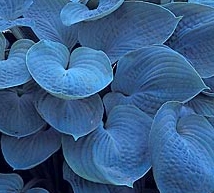
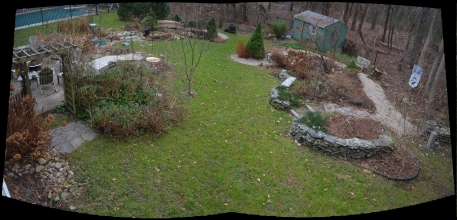


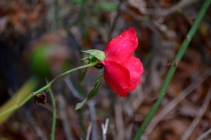

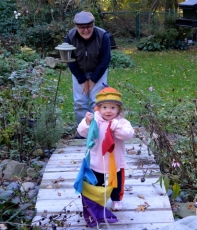
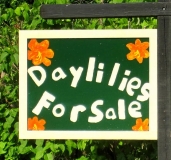


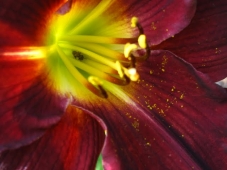
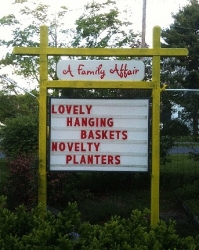
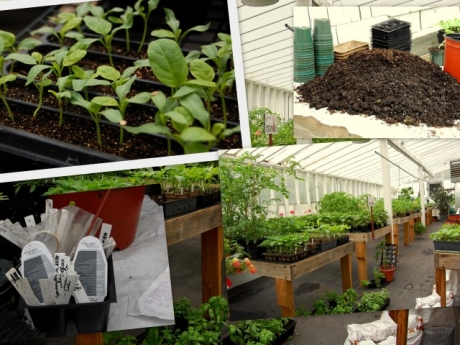
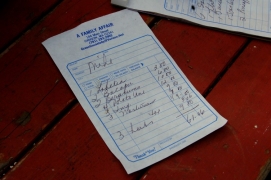
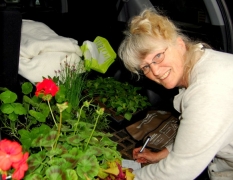
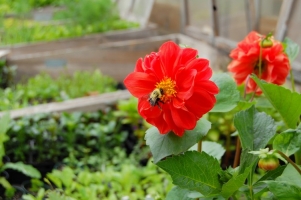
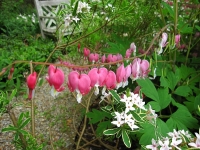
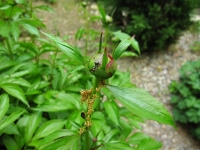
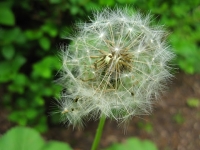

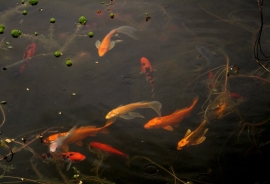
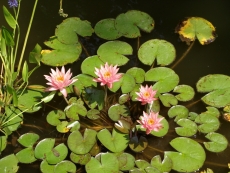
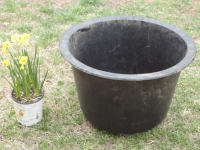
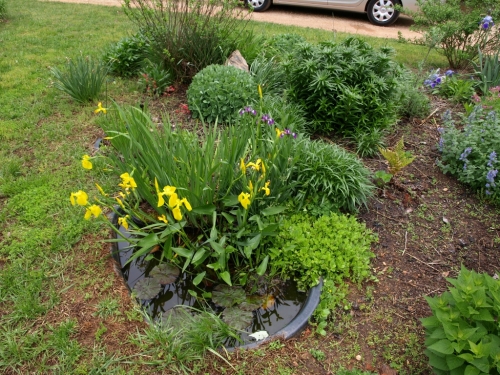
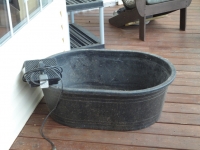


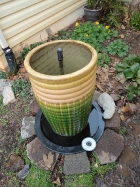 Level the pot for the best overflow
Level the pot for the best overflow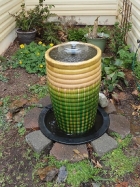 Fountain in action
Fountain in action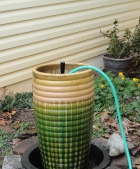 Fill the pot and basin with water
Fill the pot and basin with water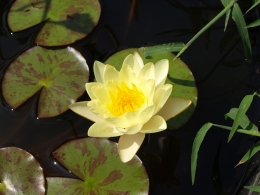

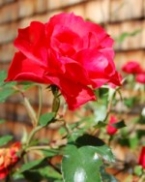
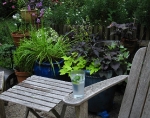 pots-with-chair
pots-with-chair potted-herbs-annuals
potted-herbs-annuals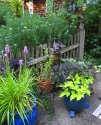 pots-with-chair2
pots-with-chair2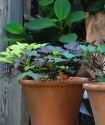 pots-sweetpotato
pots-sweetpotato